经济学中的英文词缩写
- 格式:doc
- 大小:65.50 KB
- 文档页数:3
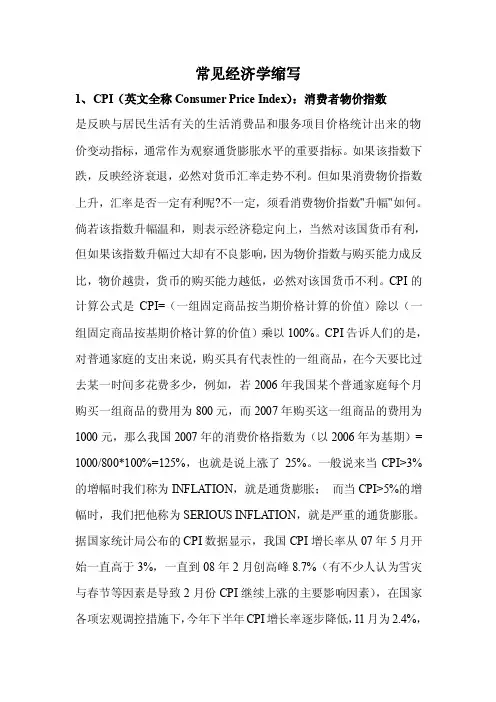
常见经济学缩写1、CPI(英文全称Consumer Price Index):消费者物价指数是反映与居民生活有关的生活消费品和服务项目价格统计出来的物价变动指标,通常作为观察通货膨胀水平的重要指标。
如果该指数下跌,反映经济衰退,必然对货币汇率走势不利。
但如果消费物价指数上升,汇率是否一定有利呢?不一定,须看消费物价指数"升幅"如何。
倘若该指数升幅温和,则表示经济稳定向上,当然对该国货币有利,但如果该指数升幅过大却有不良影响,因为物价指数与购买能力成反比,物价越贵,货币的购买能力越低,必然对该国货币不利。
CPI的计算公式是CPI=(一组固定商品按当期价格计算的价值)除以(一组固定商品按基期价格计算的价值)乘以100%。
CPI告诉人们的是,对普通家庭的支出来说,购买具有代表性的一组商品,在今天要比过去某一时间多花费多少,例如,若2006年我国某个普通家庭每个月购买一组商品的费用为800元,而2007年购买这一组商品的费用为1000元,那么我国2007年的消费价格指数为(以2006年为基期)= 1000/800*100%=125%,也就是说上涨了25%。
一般说来当CPI>3%的增幅时我们称为INFLA TION,就是通货膨胀;而当CPI>5%的增幅时,我们把他称为SERIOUS INFLA TION,就是严重的通货膨胀。
据国家统计局公布的CPI数据显示,我国CPI增长率从07年5月开始一直高于3%,一直到08年2月创高峰8.7%(有不少人认为雪灾与春节等因素是导致2月份CPI继续上涨的主要影响因素),在国家各项宏观调控措施下,今年下半年CPI增长率逐步降低,11月为2.4%,也就是表示,生活成本比之前前平均上升2.4%。
当生活成本提高,你的金钱价值便随之下降。
2、PPI(英文全称Producer Price Index):生产者物价指数是衡量工业企业产品出厂价格变动趋势和变动程度的指数,是反映某一时期生产领域价格变动情况的重要经济指标,也是制定有关经济政策和国民经济核算的重要依据。

微观经济学中各个字母缩写对应的中英文意思Company number:【WTUT-WT88Y-W8BBGB-BWYTT-19998】P:价格Price Q:数量Number D:需求Demand S供给Supply E:均衡(或期望)Equilibrium 效用Utility TU:Total utility总效用 MU:Marginal utility边际效用 CS: Consumer surplus消费者剩余MRS:商品的边际替代率Marginal rate of substitutionL:劳动力Labor TP:总产量 AP:平均产量 MP:边际产量 MRTS:边际技术替代率 STC:短期总成本土地( Land)成本(Capital)边际效用( Marginal utility)利润(Profit)长期(Long run)TFC:总不变成本Total fixed costTVC:总可变成本Total variable costTC:总成本Total costAFC:平均不变成本Average fixed costAVC:平均可变成本Average variable cost)AC:平均总成本Average total cost 平均成本(Average cost)MC:边际成本Marginal costLTC:长期总成本Long run total costLAC:长期平均成本Long run average costSAC:短期平均成本Short run average costLMC:长期边际成本Long run marginal costSMC:短期边际成本Short run marginal costTR:总收益Total revenueAR:平均收益Average revenueMR:边际收益Marginal revenueMP:边际产品(Marginal product)VMP:边际产品价值Value of the marginal product MRP:边际收益产品Marginal revenue product MFC:边际要素成本Marginal cost of factor PEP:价格扩展线Price line extension。
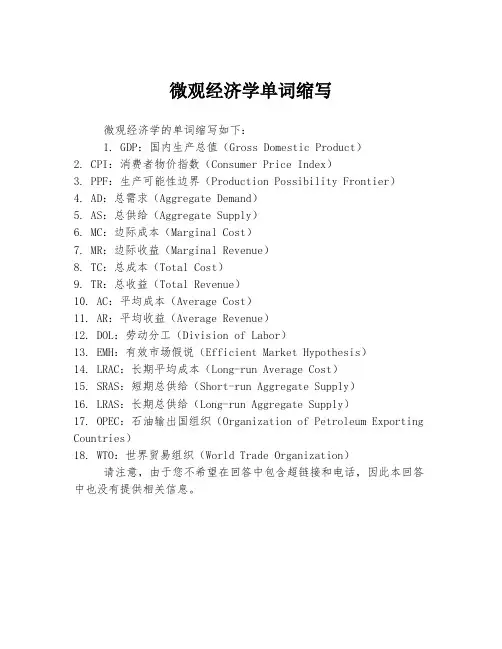
微观经济学单词缩写
微观经济学的单词缩写如下:
1. GDP:国内生产总值(Gross Domestic Product)
2. CPI:消费者物价指数(Consumer Price Index)
3. PPF:生产可能性边界(Production Possibility Frontier)
4. AD:总需求(Aggregate Demand)
5. AS:总供给(Aggregate Supply)
6. MC:边际成本(Marginal Cost)
7. MR:边际收益(Marginal Revenue)
8. TC:总成本(Total Cost)
9. TR:总收益(Total Revenue)
10. AC:平均成本(Average Cost)
11. AR:平均收益(Average Revenue)
12. DOL:劳动分工(Division of Labor)
13. EMH:有效市场假说(Efficient Market Hypothesis)
14. LRAC:长期平均成本(Long-run Average Cost)
15. SRAS:短期总供给(Short-run Aggregate Supply)
16. LRAS:长期总供给(Long-run Aggregate Supply)
17. OPEC:石油输出国组织(Organization of Petroleum Exporting Countries)
18. WTO:世界贸易组织(World Trade Organization)
请注意,由于您不希望在回答中包含超链接和电话,因此本回答中也没有提供相关信息。
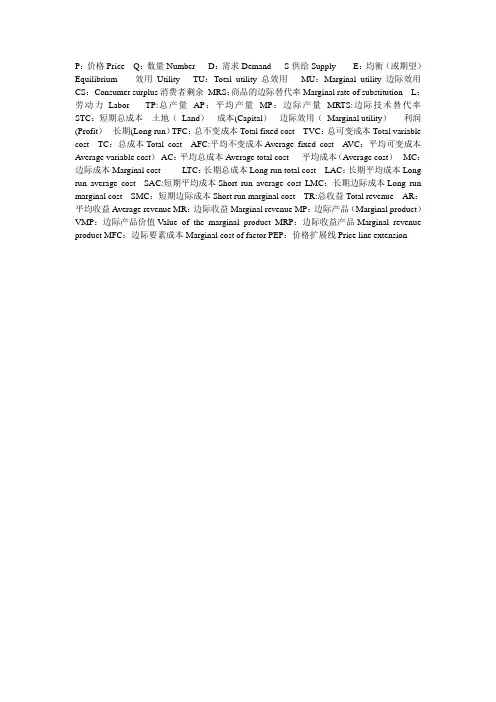
P:价格Price Q:数量Number D:需求Demand S供给Supply E:均衡(或期望)Equilibrium 效用Utility TU:Total utility总效用MU:Marginal utility边际效用CS:Consumer surplus消费者剩余MRS:商品的边际替代率Marginal rate of substitution L:劳动力Labor TP:总产量AP:平均产量MP:边际产量MRTS:边际技术替代率STC:短期总成本土地(Land)成本(Capital)边际效用(Marginal utility)利润(Profit)长期(Long run)TFC:总不变成本Total fixed cost TVC:总可变成本Total variable cost TC:总成本Total cost AFC:平均不变成本Average fixed cost A VC:平均可变成本Average variable cost)AC:平均总成本Average total cost 平均成本(Average cost)MC:边际成本Marginal cost LTC:长期总成本Long run total cost LAC:长期平均成本Long run average cost SAC:短期平均成本Short run average cost LMC:长期边际成本Long run marginal cost SMC:短期边际成本Short run marginal cost TR:总收益Total revenue AR:平均收益Average revenue MR:边际收益Marginal revenue MP:边际产品(Marginal product)VMP:边际产品价值Value of the marginal product MRP:边际收益产品Marginal revenue product MFC:边际要素成本Marginal cost of factor PEP:价格扩展线Price line extension。
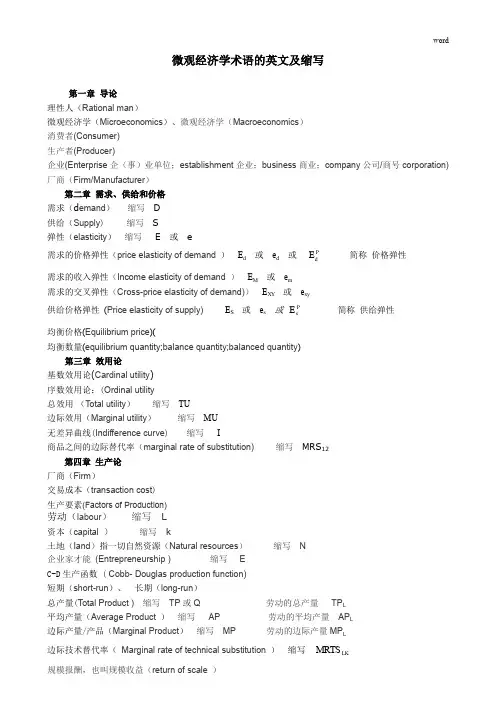
微观经济学术语的英文及缩写第一章导论理性人(Rational man)微观经济学(Microeconomics)、微观经济学(Macroeconomics)消费者(Consumer)生产者(Producer)企业(Enterprise企(事)业单位;establishment企业;business商业;company公司/商号corporation) 厂商(Firm/Manufacturer)第二章需求、供给和价格需求(d emand)缩写D供给(Supply) 缩写S弹性(elasticity)缩写 E 或 eE简称价格弹性需求的价格弹性(price elasticity of demand )E d或e d 或Pd需求的收入弹性(Income elasticity of demand )E M或e m需求的交叉弹性(Cross-price elasticity of demand))E XY或e xyE简称供给弹性供给价格弹性(Price elasticity of supply)E S或e s 或Ps均衡价格(Equilibrium price)(均衡数量(equilibrium quantity;balance quantity;balanced quantity)第三章效用论基数效用论(Cardinal utility)序数效用论:(Ordinal utility总效用(T otal utility)缩写TU边际效用(Marginal utility)缩写MU无差异曲线(Indifference curve) 缩写I商品之间的边际替代率(marginal rate of substitution) 缩写MRS12第四章生产论厂商(Firm)交易成本(transaction cost)生产要素(Factors of Production)劳动(labour)缩写L资本(capital )缩写k土地(Iand)指一切自然资源(Natural resources)缩写N企业家才能(Entrepreneurship ) 缩写 EC-D生产函数 ( Cobb- Douglas production function)短期(short-run)、长期(long-run)总产量(Total Product ) 缩写TP或Q 劳动的总产量TP L平均产量(Average Product )缩写AP 劳动的平均产量AP L边际产量/产品(Marginal Product)缩写MP 劳动的边际产量MP LMRTS边际技术替代率(Marginal rate of technical substitution )缩写LK规模报酬,也叫规模收益(return of scale )分increasing returns of scale、constant returns of scale、decreasing returns of scale等成本线(Isocost line)等产量线(Isoquant line)第五章成本论成本(cost) 缩写 C费用(expense)机会成本(Opportunity cost)显成本(Explicit cost)隐成本(Implicit cost)正常利润(Normal profit)超额利润(Excess profit)或叫经济利润(Econormic profit)经常用π表示、利润最大化(profit maximization)利润最大化原则(principle of profit maximization)短期总成本(Short-run total cost)缩写STC 或TC总固定成本(T otal fixed cost)缩写TFC 或FC总变动成本(T otal variable cos t)缩写TVC 或VC平均固定成本(Average fixed cost ) 缩写AFC平均可变成本(Average variable cost ) AVC短期平均成本(Short-run average cost) SAC 或AC短期边际成本(Short-run marginal cos t) SMC 或MC长期总成本(Long-run total cost)LTC 或TC长期平均成本(Long-run average cos t) LAC 或AC长期边际成本(Long-run marginal cost) LMC 或MC规模经济(Economies of scale)、规模不经济(Diseconomies of scale)外在经济(The external economy)、外在不经济(External diseconomy)收益(Revenue)R总收益( total revenue;gross earnings;gross income) TR平均收益(average revenue)AR边际收益(marginal income )MR第六章完全竞争市场市场结构(Market structure)完全竞争市场(perfect competition market)长期供给线(Long-run supply curve) LS消费者剩余(C onsumer’s surplus)CS生产者剩余(P roducer’s surplus) PS (Producer surplus)看不见手的原理(Invisible hand theorem)第七章不完全竞争市场(Imperfect competition market)完全垄断市场(Complete monopoly market (Monopoly):卖方垄断(Monopoly)/买方(Monopsony)垄断竞争(Monopolistic Competition )/垄断竞争市场(Monopolistic Competition Market)寡头垄断(Oligopsony)/寡头垄断市场(Oligopsony market)价格歧视(Price discrimination)一级价格歧视(First-degree price discrimination)二级价格歧视(Second- degree price discrimination)三级价格歧视(Third-degree price discrimination)博弈论(Game theory)纳什均衡(Nash equilibrium)囚犯困境(prisoners’ dilemma)第八章生产要素边际收益产品(Marginal Revenue Product)MRP边际产品价值(Value of marginal product) VMP边际要素成本(Marginal Factor Cost)MFC工资( Wage) w 最低工资minimum wage实际工资(Real wages)\名义工资(Normal wages)地租/ 租金(rent) R利息(Interest) 、利率(Interest rate)缩写r实际利率(Real Interest rate)、名义利率(Normal Interest rate)洛伦慈曲线(Lorenz curve)基尼系数( Gink coefficient ) 缩写G第十章一般均衡和福利经济学(这一章不用看)埃奇沃思盒(Edgeworth’s Box)帕累托最优(Pareto-optimality) 帕累托最优状态帕累托效率(Pareto efficiency)、帕累托改进(Pareto improvement)福利经济学(welfare economics)福利经济学第一定律(First Fundamental Theorem of Welfare Economics)福利经济学第二定律(Second Fundamental Theorem of Welfare Economics)边际生产转换率(the marginal rateof product transformation)MRTS XY边际转换率(marginal rate of transformation)MTS XY =MRTS XY =ΔY/ΔX第十一章微观经济政策市场失灵(market failure)外部影响(External effects) 、外部效应Externalities外部经济(external economies )、外部不经济(external diseconomies)私人成本(private cost;personal cost)、社会成本(social cost)科斯定理(Kos's theorem)the Coase theorem (科斯定理)共有财产(community of goods;joint property)私人物品(private goodst)、公共物品(Public goods)搭便车(Free ride / Free-Riding)或thumb a lift [or ride];hitchhike;pick up; hitch a ride)搭便车者pick up a hitch-hiker竞争性(Competitive)、非竞争性non-competitive/ non-rival排他性(Exclusive)、非排他性non-exclusive /nonexcludable公共选择(Public choice)完全信息(C omplete information)、不完全信息(Imperfect information;incomplete information)不对称信息(Asymmetric Information)逆向选择(Adverse Selection)道德风险(Moral hazard)次品市场(lemon market) :柠檬市场(lemon market),lemon market problem也叫asymmetric informationproblem (信息不对称问题)次品(substandard [shoddy] products;substandard)。
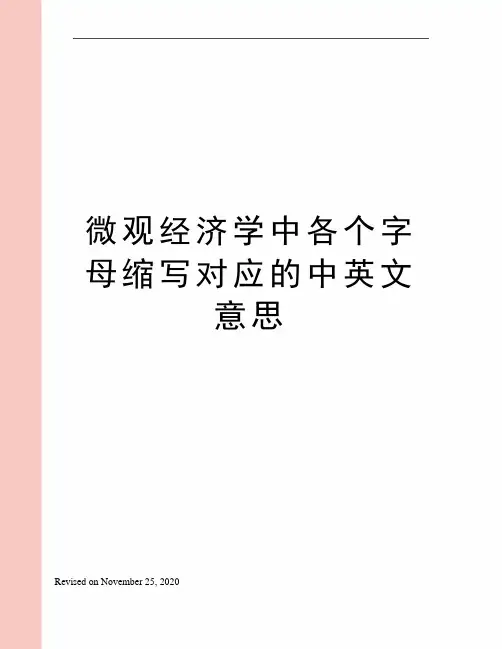
微观经济学中各个字母缩写对应的中英文意思Revised on November 25, 2020P:价格Price Q:数量Number D:需求Demand S供给Supply E:均衡(或期望)Equilibrium 效用Utility TU:Total utility总效用 MU:Marginal utility边际效用 CS: Consumer surplus消费者剩余MRS:商品的边际替代率Marginal rate of substitutionL:劳动力Labor TP:总产量 AP:平均产量 MP:边际产量 MRTS:边际技术替代率 STC:短期总成本土地( Land)成本(Capital)边际效用( Marginal utility)利润(Profit)长期(Long run)TFC:总不变成本Total fixed costTVC:总可变成本Total variable costTC:总成本Total costAFC:平均不变成本Average fixed costAVC:平均可变成本Average variable cost)AC:平均总成本Average total cost 平均成本(Average cost)MC:边际成本Marginal costLTC:长期总成本Long run total costLAC:长期平均成本Long run average costSAC:短期平均成本Short run average costLMC:长期边际成本Long run marginal costSMC:短期边际成本Short run marginal costTR:总收益Total revenueAR:平均收益Average revenueMR:边际收益Marginal revenueMP:边际产品(Marginal product)VMP:边际产品价值Value of the marginal product MRP:边际收益产品Marginal revenue product MFC:边际要素成本Marginal cost of factor PEP:价格扩展线Price line extension。
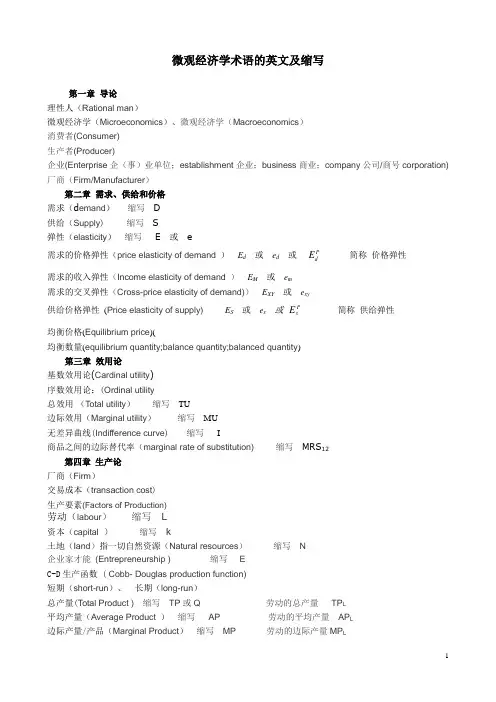
微观经济学术语的英文及缩写第一章导论理性人(Rational man)微观经济学(Microeconomics)、微观经济学(Macroeconomics)消费者(Consumer)生产者(Producer)企业(Enterprise企(事)业单位;establishment企业;business商业;company公司/商号corporation) 厂商(Firm/Manufacturer)第二章需求、供给和价格需求(d emand)缩写D供给(Supply) 缩写S弹性(elasticity)缩写 E 或 eE简称价格弹性需求的价格弹性(price elasticity of demand )E d或e d 或Pd需求的收入弹性(Income elasticity of demand )E M或e m需求的交叉弹性(Cross-price elasticity of demand))E XY或e xy供给价格弹性(Price elasticity of supply)E S或e s 或P s E简称供给弹性均衡价格(Equilibrium price)(均衡数量(equilibrium quantity;balance quantity;balanced quantity)第三章效用论基数效用论(Cardinal utility)序数效用论:(Ordinal utility总效用(T otal utility)缩写TU边际效用(Marginal utility)缩写MU无差异曲线(Indifference curve) 缩写I商品之间的边际替代率(marginal rate of substitution) 缩写MRS12第四章生产论厂商(Firm)交易成本(transaction cost)生产要素(Factors of Production)劳动(labour)缩写L资本(capital )缩写k土地(Iand)指一切自然资源(Natural resources)缩写N企业家才能(Entrepreneurship ) 缩写 EC-D生产函数 ( Cobb- Douglas production function)短期(short-run)、长期(long-run)总产量(Total Product ) 缩写TP或Q 劳动的总产量TP L平均产量(Average Product )缩写AP 劳动的平均产量AP L边际产量/产品(Marginal Product)缩写MP 劳动的边际产量MP LMRTS边际技术替代率(Marginal rate of technical substitution )缩写LK规模报酬,也叫规模收益(return of scale )分increasing returns of scale、constant returns of scale、decreasing returns of scale等成本线(Isocost line)等产量线(Isoquant line)第五章成本论成本(cost) 缩写 C费用(expense)机会成本(Opportunity cost)显成本(Explicit cost)隐成本(Implicit cost)正常利润(Normal profit)超额利润(Excess profit)或叫经济利润(Econormic profit)经常用π表示、利润最大化(profit maximization)利润最大化原则(principle of profit maximization)短期总成本(Short-run total cost)缩写STC 或TC总固定成本(T otal fixed cost)缩写TFC 或FC总变动成本(T otal variable cos t)缩写TVC 或VC平均固定成本(Average fixed cost ) 缩写AFC平均可变成本(Average variable cost ) AVC短期平均成本(Short-run average cost) SAC 或AC短期边际成本(Short-run marginal cos t) SMC 或MC长期总成本(Long-run total cost)LTC 或TC长期平均成本(Long-run average cos t) LAC 或AC长期边际成本(Long-run marginal cost) LMC 或MC规模经济(Economies of scale)、规模不经济(Diseconomies of scale)外在经济(The external economy)、外在不经济(External diseconomy)收益(Revenue)R总收益( total revenue;gross earnings;gross income) TR平均收益(average revenue)AR边际收益(marginal income )MR第六章完全竞争市场市场结构(Market structure)完全竞争市场(perfect competition market)长期供给线(Long-run supply curve) LS消费者剩余(Consumer’s surplus)CS生产者剩余(Producer’s surplus) PS (Producer surplus)看不见手的原理(Invisible hand theorem)第七章不完全竞争市场(Imperfect competition market)完全垄断市场(Complete monopoly market (Monopoly):卖方垄断(Monopoly)/买方(Monopsony)垄断竞争(Monopolistic Competition )/垄断竞争市场(Monopolistic Competition Market)寡头垄断(Oligopsony)/寡头垄断市场(Oligopsony market)价格歧视(Price discrimination)一级价格歧视(First-degree price discrimination)二级价格歧视(Second- degree price discrimination)三级价格歧视(Third-degree price discrimination)博弈论(Game theory)纳什均衡(Nash equilibrium)囚犯困境(prisoners’ dilemma)第八章生产要素边际收益产品(Marginal Revenue Product)MRP边际产品价值(Value of marginal product) VMP边际要素成本(Marginal Factor Cost)MFC工资( Wage) w 最低工资minimum wage实际工资(Real wages)\名义工资(Normal wages)地租/ 租金(rent) R利息(Interest) 、利率(Interest rate)缩写r实际利率(Real Interest rate)、名义利率(Normal Interest rate)洛伦慈曲线(Lorenz curve)基尼系数( Gink coefficient ) 缩写G第十章一般均衡和福利经济学(这一章不用看)埃奇沃思盒(Edgeworth’s Box)帕累托最优(Pareto-optimality) 帕累托最优状态帕累托效率(Pareto efficiency)、帕累托改进(Pareto improvement)福利经济学(welfare economics)福利经济学第一定律(First Fundamental Theorem of Welfare Economics)福利经济学第二定律(Second Fundamental Theorem of Welfare Economics)边际生产转换率(the marginal rateof product transformation)MRTS XY边际转换率(marginal rate of transformation)MTS XY =MRTS XY =ΔY/ΔX第十一章微观经济政策市场失灵(market failure)外部影响(External effects) 、外部效应Externalities外部经济(external economies )、外部不经济(external diseconomies)私人成本(private cost;personal cost)、社会成本(social cost)科斯定理(Kos's theorem)the Coase theorem (科斯定理)共有财产(community of goods;joint property)私人物品(private goodst)、公共物品(Public goods)搭便车(Free ride / Free-Riding)或thumb a lift [or ride];hitchhike;pick up; hitch a ride)搭便车者pick up a hitch-hiker竞争性(Competitive)、非竞争性non-competitive/ non-rival排他性(Exclusive)、非排他性non-exclusive /nonexcludable公共选择(Public choice)完全信息(C omplete information)、不完全信息(Imperfect information;incomplete information)不对称信息(Asymmetric Information)逆向选择(Adverse Selection)道德风险(Moral hazard)次品市场(lemon market) :柠檬市场(lemon market),lemon market problem也叫asymmetric informationproblem (信息不对称问题)次品(substandard [shoddy] products;substandard)。
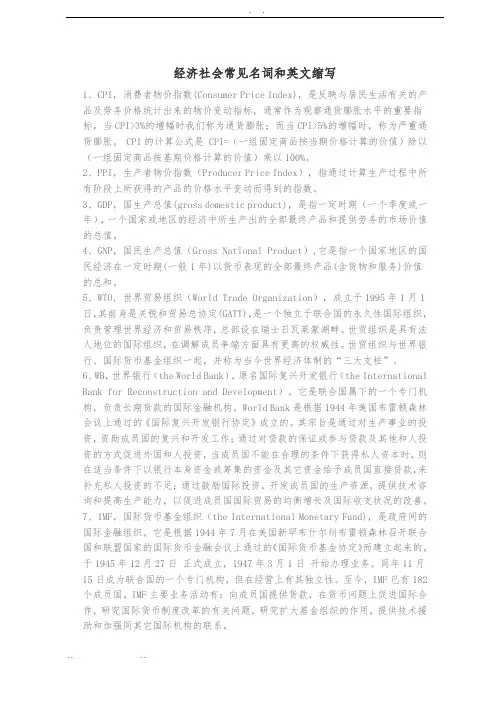
. .经济社会常见名词和英文缩写1、CPI,消费者物价指数(Consumer Price Index),是反映与居民生活有关的产品及劳务价格统计出来的物价变动指标,通常作为观察通货膨胀水平的重要指标。
当CPI>3%的增幅时我们称为通货膨胀;而当CPI>5%的增幅时,称为严重通货膨胀。
CPI的计算公式是 CPI=(一组固定商品按当期价格计算的价值)除以(一组固定商品按基期价格计算的价值)乘以100%。
2、PPI,生产者物价指数(Producer Price Index),指通过计算生产过程中所有阶段上所获得的产品的价格水平变动而得到的指数。
3、GDP,国生产总值(gross domestic product),是指一定时期(一个季度或一年),一个国家或地区的经济中所生产出的全部最终产品和提供劳务的市场价值的总值。
4、GNP,国民生产总值(Gross National Product),它是指一个国家地区的国民经济在一定时期(一般1年)以货币表现的全部最终产品(含货物和服务)价值的总和。
5、WTO, 世界贸易组织(World Trade Organization),成立于1995年1月1日,其前身是关税和贸易总协定(GATT),是一个独立于联合国的永久性国际组织,负责管理世界经济和贸易秩序,总部设在瑞士日瓦莱蒙湖畔。
世贸组织是具有法人地位的国际组织,在调解成员争端方面具有更高的权威性。
世贸组织与世界银行、国际货币基金组织一起,并称为当今世界经济体制的“三大支柱”。
6、WB,世界银行(the World Bank),原名国际复兴开发银行(the International Bank for Reconstruction and Development)。
它是联合国属下的一个专门机构,负责长期货款的国际金融机构。
World Bank是根据1944年美国布雷顿森林会议上通过的《国际复兴开发银行协定》成立的。
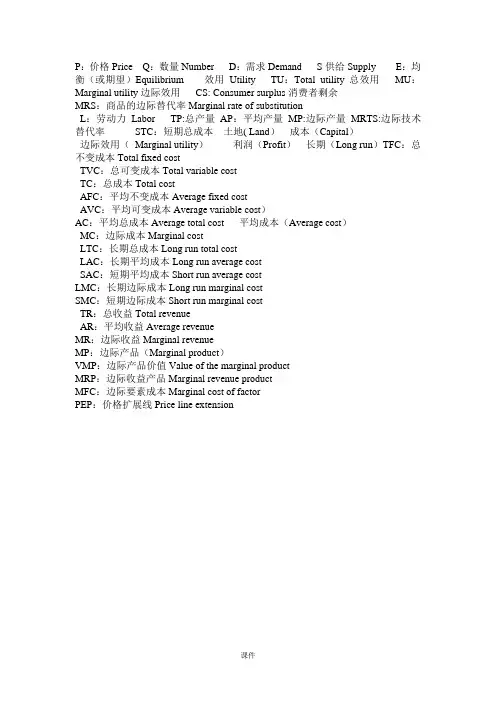
P:价格Price Q:数量Number D:需求Demand S供给Supply E:均衡(或期望)Equilibrium 效用Utility TU:Total utility总效用MU:Marginal utility边际效用CS: Consumer surplus消费者剩余MRS:商品的边际替代率Marginal rate of substitutionL:劳动力Labor TP:总产量AP:平均产量MP:边际产量MRTS:边际技术替代率STC:短期总成本土地( Land)成本(Capital)边际效用(Marginal utility)利润(Profit)长期(Long run)TFC:总不变成本Total fixed costTVC:总可变成本Total variable costTC:总成本Total costAFC:平均不变成本Average fixed costAVC:平均可变成本Average variable cost)AC:平均总成本Average total cost 平均成本(Average cost)MC:边际成本Marginal costLTC:长期总成本Long run total costLAC:长期平均成本Long run average costSAC:短期平均成本Short run average costLMC:长期边际成本Long run marginal costSMC:短期边际成本Short run marginal costTR:总收益Total revenueAR:平均收益Average revenueMR:边际收益Marginal revenueMP:边际产品(Marginal product)VMP:边际产品价值Value of the marginal productMRP:边际收益产品Marginal revenue productMFC:边际要素成本Marginal cost of factorPEP:价格扩展线Price line extension课件。
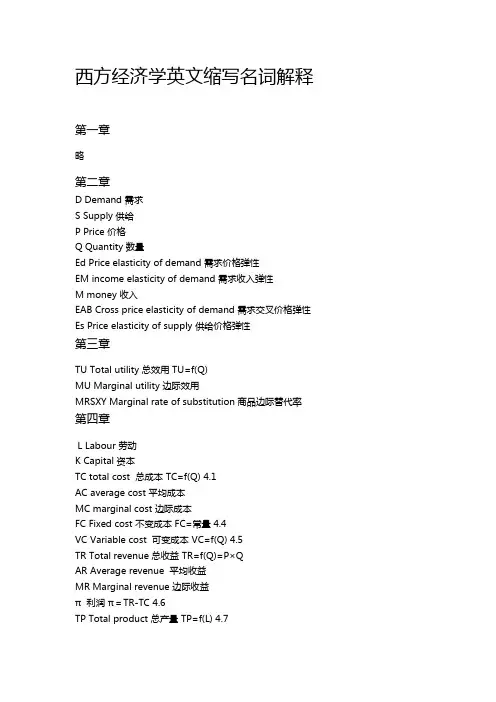
西方经济学英文缩写名词解释第一章略第二章D Demand 需求S Supply 供给P Price 价格Q Quantity 数量Ed Price elasticity of demand 需求价格弹性EM income elasticity of demand 需求收入弹性M money 收入EAB Cross price elasticity of demand 需求交叉价格弹性Es Price elasticity of supply 供给价格弹性第三章TU Total utility 总效用 TU=f(Q)MU Marginal utility 边际效用MRSXY Marginal rate of substitution 商品边际替代率第四章L Labour 劳动K Capital 资本TC total cost 总成本 TC=f(Q) 4.1AC average cost 平均成本MC marginal cost 边际成本FC Fixed cost 不变成本 FC=常量 4.4VC Variable cost 可变成本 VC=f(Q) 4.5TR Total revenue 总收益TR=f(Q)=P×QAR Average revenue 平均收益MR Marginal revenue 边际收益π利润π=TR-TC 4.6TP Total product 总产量 TP=f(L) 4.7精选文库AP Average product 平均产量MP Marginal product 边际产量MRTSLK Marginal rate of technical substitution 边际技术替代率STC Short-run total cost 短期总成本 STC=f(Q)=FC+VCSTFC(FC) Short-run total fixed cost 短期总不变成本(固定成本) STFC=常量STVC(VC) Short-run total variable cost 短期总可变成本(可变成本) STVC=f(Q) SAC(ATC) Short-run average cost 短期平均成本SAFC(AFC) Short-run average fixed cost (短期)平均固定成本SAVC(AVC) Short-run average variable cost (短期)平均可变成本SMC Short-run marginal cost 短期边际成本LTC Long-run total cost 长期总成本 LTC=f(Q)LAC Long-run average cost 长期平均成本LMC Long-run marginal cost 长期边际成本第六章VMP Value of marginal product 边际产品价值MRP Marginal revenue product 边际收益产量W Wage 工资第九章GDP Gross demestic product 国内生产总值C Consumption 消费 C=f(Y)=C0+bY 9.1I Investment 投资G Government payment 政府购买NX Net export 净出口 NX=X-MX export 出口M import 进口NDP Net domestic product 国内生产净值NI National income 国民收入PI Personal income 个人收入PDI Personal disposable income 个人可支配收入GNP Gross national product 国民生产总值第十章精选文库Y 总量APC Average propensity to consumption 平均消费倾向MPC marginal propensity to consumption 边际消费倾向S Save 储蓄APS Average propensity to save 平均储蓄倾向MPS marginal propensity to save 边际储蓄倾向AD Aggregate demand 总需求 AD=C+I+G+XAS Aggregate supply 总供给 AS=C+S+T+MT tax 税收K multiplier 乘数第十一章MEC Marginal efficiency of capital 资本边际效率L Demand for money 货币需求 L=L1(Y)+L2(R)R Rate 利率M Money supply 货币供给第十三章CPI Consumer price index 消费物价指数第十四章KG Government expenditure multiplier 政府购买支出乘数KTR Transfer payment multiplier 转移支付乘数 14.2TR transfer 转移支付KT Tax multiplier 税收乘数KB Balanced budget multiplier 平衡预算乘数第十五章Mh Money base 基础货币(高能货币) Mh=M0+RE 15.1Ke Deposit expansion multiplier 存款乘数Km Money multiplier 货币乘数第十六章M import 进口 M=M0+mYKX Foreign trade multiplier 对外贸易乘数第十七章精选文库G rate of growth 经济增长率Gt 实际增长率Gw Warranted rate of growth 合意增长率Gn Nature rate of growth 实际增长率。
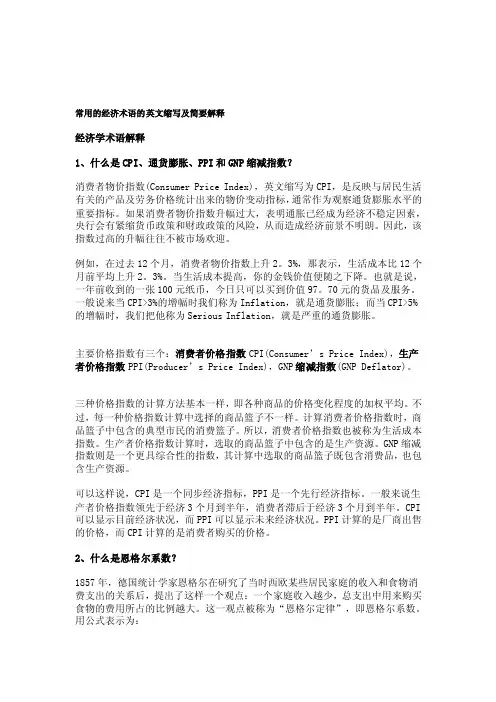
常用的经济术语的英文缩写及简要解释经济学术语解释1、什么是CPI、通货膨胀、PPI和GNP缩减指数?消费者物价指数(Consumer Price Index),英文缩写为CPI,是反映与居民生活有关的产品及劳务价格统计出来的物价变动指标,通常作为观察通货膨胀水平的重要指标。
如果消费者物价指数升幅过大,表明通胀已经成为经济不稳定因素,央行会有紧缩货币政策和财政政策的风险,从而造成经济前景不明朗。
因此,该指数过高的升幅往往不被市场欢迎。
例如,在过去12个月,消费者物价指数上升2。
3%,那表示,生活成本比12个月前平均上升2。
3%。
当生活成本提高,你的金钱价值便随之下降。
也就是说,一年前收到的一张100元纸币,今日只可以买到价值97。
70元的货品及服务。
一般说来当CPI>3%的增幅时我们称为Inflation,就是通货膨胀;而当CPI>5%的增幅时,我们把他称为Serious Inflation,就是严重的通货膨胀。
主要价格指数有三个:消费者价格指数CPI(Consumer’s Price Index),生产者价格指数PPI(Producer’s Price Index),GNP缩减指数(GNP Deflator)。
三种价格指数的计算方法基本一样,即各种商品的价格变化程度的加权平均。
不过,每一种价格指数计算中选择的商品篮子不一样。
计算消费者价格指数时,商品篮子中包含的典型市民的消费篮子。
所以,消费者价格指数也被称为生活成本指数。
生产者价格指数计算时,选取的商品篮子中包含的是生产资源。
GNP缩减指数则是一个更具综合性的指数,其计算中选取的商品篮子既包含消费品,也包含生产资源。
可以这样说,CPI是一个同步经济指标,PPI是一个先行经济指标。
一般来说生产者价格指数领先于经济3个月到半年,消费者滞后于经济3个月到半年。
CPI 可以显示目前经济状况,而PPI可以显示未来经济状况。
PPI计算的是厂商出售的价格,而CPI计算的是消费者购买的价格。
微观经济学术语的英文及缩写第一章导论理性人(Rational man)微观经济学(Microeconomics)、微观经济学(Macroeconomics)消费者(Consumer)生产者(Producer)企业(Enterprise企(事)业单位;establishment企业;business商业;company公司/商号corporation) 厂商(Firm/Manufacturer)第二章需求、供给与价格需求(d emand) 缩写D供给(Supply) 缩写S弹性(elasticity) 缩写 E 或 eE简称价格弹性需求的价格弹性(price elasticity of demand ) E d或e d 或Pd需求的收入弹性(Income elasticity of demand )E M或e m需求的交叉弹性(Cross-price elasticity of demand))E XY或e xyE简称供给弹性供给价格弹性(Price elasticity of supply)E S或e s 或Ps均衡价格(Equilibrium price)(均衡数量(equilibrium quantity;balance quantity;balanced quantity)第三章效用论基数效用论(Cardinal utility)序数效用论:(Ordinal utility总效用(T otal utility) 缩写TU边际效用(Marginal utility) 缩写MU无差异曲线(Indifference curve) 缩写I商品之间的边际替代率(marginal rate of substitution) 缩写MRS12第四章生产论厂商(Firm)交易成本(transaction cost)生产要素(Factors of Production)劳动(labour) 缩写L资本(capital )缩写k土地(Iand)指一切自然资源(Natural resources) 缩写N企业家才能(Entrepreneurship ) 缩写 EC-D生产函数 ( Cobb- Douglas production function)短期(short-run)、长期(long-run)总产量(Total Product ) 缩写TP或Q 劳动的总产量TP L平均产量(Average Product ) 缩写AP 劳动的平均产量AP L边际产量/产品(Marginal Product) 缩写MP 劳动的边际产量MP LMRTS边际技术替代率( Marginal rate of technical substitution ) 缩写LK规模报酬,也叫规模收益(return of scale )分increasing returns of scale、constant returns of scale、decreasing returns of scale 等成本线(Isocost line)等产量线(Isoquant line)第五章成本论成本(cost) 缩写 C费用(expense)机会成本(Opportunity cost)显成本(Explicit cost)隐成本(Implicit cost)正常利润(Normal profit)超额利润(Excess profit)或叫经济利润(Econormic profit) 经常用π表示、利润最大化(profit maximization)利润最大化原则(principle of profit maximization)短期总成本(Short-run total cost) 缩写STC 或TC总固定成本(Total fixed cost) 缩写TFC 或FC总变动成本(Total variable cos t) 缩写TVC 或VC平均固定成本(Average fixed cost ) 缩写AFC平均可变成本(Average variable cost ) AVC短期平均成本(Short-run average cost) SAC 或AC短期边际成本(Short-run marginal cos t) SMC 或MC长期总成本(Long-run total cost) LTC 或TC长期平均成本(Long-run average cos t) LAC 或AC长期边际成本(Long-run marginal cost) LMC 或MC规模经济(Economies of scale)、规模不经济(Diseconomies of scale)外在经济(The external economy)、外在不经济(External diseconomy)收益(Revenue) R总收益( total revenue;gross earnings;gross income) TR平均收益(average revenue)AR边际收益(marginal income ) MR第六章完全竞争市场市场结构(Market structure)完全竞争市场(perfect competition market)长期供给线(Long-run supply curve) LS消费者剩余(Consumer’s surplus) CS生产者剩余(Producer’s surplus) PS (Producer surplus)瞧不见手的原理(Invisible hand theorem)第七章不完全竞争市场(Imperfect competition market)完全垄断市场(Complete monopoly market (Monopoly):卖方垄断(Monopoly)/买方(Monopsony) 垄断竞争(Monopolistic Competition )/垄断竞争市场(Monopolistic Competition Market)寡头垄断(Oligopsony)/寡头垄断市场(Oligopsony market)价格歧视(Price discrimination)一级价格歧视(First-degree price discrimination)二级价格歧视(Second- degree price discrimination)三级价格歧视(Third-degree price discrimination)博弈论(Game theory)纳什均衡(Nash equilibrium)囚犯困境(prisoners’ dilemma)第八章生产要素边际收益产品(Marginal Revenue Product) MRP边际产品价值(Value of marginal product) VMP边际要素成本(Marginal Factor Cost) MFC工资( Wage) w 最低工资minimum wage实际工资(Real wages)\名义工资(Normal wages)地租/ 租金(rent) R利息(Interest) 、利率( Interest rate)缩写r实际利率(Real Interest rate)、名义利率(Normal Interest rate)洛伦慈曲线(Lorenz curve)基尼系数( Gink coefficient ) 缩写G第十章一般均衡与福利经济学(这一章不用瞧)埃奇沃思盒(Edgeworth’s Box)帕累托最优(Pareto-optimality) 帕累托最优状态帕累托效率(Pareto efficiency)、帕累托改进(Pareto improvement)福利经济学(welfare economics)福利经济学第一定律(First Fundamental Theorem of Welfare Economics)福利经济学第二定律(Second Fundamental Theorem of Welfare Economics)边际生产转换率(the marginal rateof product transformation) MRTS XY边际转换率(marginal rate of transformation) MTS XY =MRTS XY =ΔY/ΔX第十一章微观经济政策市场失灵(market failure)外部影响(External effects) 、外部效应Externalities外部经济(external economies )、外部不经济(external diseconomies)私人成本(private cost;personal cost)、社会成本(social cost)科斯定理(Kos's theorem)the Coase theorem (科斯定理)共有财产(community of goods;joint property)私人物品(private goodst)、公共物品(Public goods)搭便车(Free ride / Free-Riding)或thumb a lift [or ride];hitchhike;pick up; hitch a ride)搭便车者pick up a hitch-hiker竞争性(Competitive)、非竞争性non-competitive/ non-rival排她性(Exclusive)、非排她性non-exclusive /nonexcludable公共选择(Public choice)完全信息(C omplete information)、不完全信息(Imperfect information;incomplete information)不对称信息(Asymmetric Information)逆向选择(Adverse Selection)道德风险(Moral hazard)次品市场(lemon market) :柠檬市场(lemon market),lemon market problem也叫asymmetric informationproblem (信息不对称问题)次品(substandard [shoddy] products;substandard)。
微观经济学中各个字母缩写对应的中英文意思集团文件发布号:(9816-UATWW-MWUB-WUNN-INNUL-DQQTY-P:价格Price Q:数量Number D:需求Demand S供给Supply E:均衡(或期望)Equilibrium 效用Utility TU:Total utility 总效用 MU:Marginal utility边际效用 CS: Consumer surplus消费者剩余MRS:商品的边际替代率Marginal rate of substitutionL:劳动力Labor TP:总产量 AP:平均产量 MP:边际产量 MRTS:边际技术替代率 STC:短期总成本土地( Land)成本(Capital)边际效用( Marginal utility)利润(Profit)长期(Long run)TFC:总不变成本Total fixed costTVC:总可变成本Total variable costTC:总成本Total costAFC:平均不变成本Average fixed costAVC:平均可变成本Average variable cost)AC:平均总成本Average total cost 平均成本(Average cost)MC:边际成本Marginal costLTC:长期总成本Long run total costLAC:长期平均成本Long run average costSAC:短期平均成本Short run average costLMC:长期边际成本Long run marginal costSMC:短期边际成本Short run marginal costTR:总收益Total revenueAR:平均收益Average revenueMR:边际收益Marginal revenueMP:边际产品(Marginal product)VMP:边际产品价值Value of the marginal product MRP:边际收益产品Marginal revenue product MFC:边际要素成本Marginal cost of factor PEP:价格扩展线Price line extension。
P:价格Price Q:数量Number D:需求Demand S供给Supply E:均衡(或期望)Equilibrium 效用Utility TU:Total utility总效用MU:Marginal utility边际效用CS: Consumer surplus消费者剩余MRS:商品的边际替代率Marginal rate of substitutionL:劳动力Labor TP:总产量AP:平均产量MP:边际产量MRTS:边际技术替代率STC:短期总成本土地( Land)成本(Capital)边际效用(Marginal utility)利润(Profit)长期(Long run)TFC:总不变成本Total fixed costTVC:总可变成本Total variable costTC:总成本Total costAFC:平均不变成本Average fixed costAVC:平均可变成本Average variable cost)AC:平均总成本Average total cost 平均成本(Average cost)MC:边际成本Marginal costLTC:长期总成本Long run total costLAC:长期平均成本Long run average costSAC:短期平均成本Short run average costLMC:长期边际成本Long run marginal costSMC:短期边际成本Short run marginal costTR:总收益Total revenueAR:平均收益Average revenueMR:边际收益Marginal revenueMP:边际产品(Marginal product)VMP:边际产品价值Value of the marginal productMRP:边际收益产品Marginal revenue productMFC:边际要素成本Marginal cost of factorPEP:价格扩展线Price line extension第一单元文化遗产阅读一寻找琥珀普鲁士国王腓特烈·威廉一世从未想过他送个普鲁士人民伟大的礼物会有一点如此惊奇的历史。
GDP(Gross Domestic Produc):全称国内生产总值,是指在一定时期内(一个季度或一年),一个国家或地区的经济中所生产出的全部最终产品和劳务的价值,常被公认为衡量国家经济状况的最佳指标。
它不但可反映一个国家的经济表现,更可以反映一国的国力与财富。
一般来说,国内生产总值共有四个不同的组成部分,其中包括消费、私人投资、政府支出和净出口额。
用公式表示为:GDP = CA + I + CB + X 式中:CA为消费、I为私人投资、 CB为政府支出、X为净出口额。
M0:流通中现金,即在银行体系以外流通的现金;M1:狭义货币供应量,即M0+企事业单位活期存款;M2:广义货币供应量,即M1+企事业单位定期存款+居民储蓄存款。
在这三个层次中,M0与消费变动密切相关,是最活跃的货币;M1反映居民和企业资金松紧变化,是经济周期波动的先行指标,流动性仅次于M0;M2流动性偏弱,但反映的是社会总需求的变化和未来通货膨胀的压力状况,通常所说的货币供应量,主要指M2。
GNP:国民生产总值(Gross National Product),一国一年内所生产的最终产品(包括劳务)的市场价值的总和,英语简称GNP,是国民收入核算中最重要的组成部分。
GDP和GNP的区别:GDP是国内生产总值,意思是在一国领土内创造的生产价值,无论是在领土内的本国人,还是外国人。
GNP是国民生产总值,意思是一国人一定时期内创造的生产总值,无论这个人是在本国领土内,还是在外国领土内。
CPI:即消费者物价指数(Consumer Price Index),英文缩写为CPI,是反映与居民生活有关的产品及劳务价格统计出来的物价变动指标,通常作为观察通货膨胀水平的重要指标。
如果消费者物价指数升幅过大,表明通胀已经成为经济不稳定因素,央行会有紧缩货币政策和财政政策的风险,从而造成经济前景不明朗。
因此,该指数过高的升幅往往不被市场欢迎。
一般说来当CPI>3%的增幅时我们称为INFLATION,就是通货膨胀;而当CPI>5%的增幅时,就是严重的通货膨胀。
常用的经济术语的英文缩写及简要解释经济学术语解释1、什么是CPI、通货膨胀、PPI和GNP缩减指数?消费者物价指数(Consumer Price Index),英文缩写为CPI,是反映与居民生活有关的产品及劳务价格统计出来的物价变动指标,通常作为观察通货膨胀水平的重要指标。
如果消费者物价指数升幅过大,表明通胀已经成为经济不稳定因素,央行会有紧缩货币政策和财政政策的风险,从而造成经济前景不明朗。
因此,该指数过高的升幅往往不被市场欢迎。
例如,在过去12个月,消费者物价指数上升2。
3%,那表示,生活成本比12个月前平均上升2。
3%。
当生活成本提高,你的金钱价值便随之下降。
也就是说,一年前收到的一张100元纸币,今日只可以买到价值97。
70元的货品及服务。
一般说来当CPI>3%的增幅时我们称为Inflation,就是通货膨胀;而当CPI>5%的增幅时,我们把他称为Serious Inflation,就是严重的通货膨胀。
主要价格指数有三个:消费者价格指数CPI(Consumer’s Price Index),生产者价格指数PPI(Producer’s Price Index),GNP缩减指数(GNP Deflator)。
三种价格指数的计算方法基本一样,即各种商品的价格变化程度的加权平均。
不过,每一种价格指数计算中选择的商品篮子不一样。
计算消费者价格指数时,商品篮子中包含的典型市民的消费篮子。
所以,消费者价格指数也被称为生活成本指数。
生产者价格指数计算时,选取的商品篮子中包含的是生产资源。
GNP缩减指数则是一个更具综合性的指数,其计算中选取的商品篮子既包含消费品,也包含生产资源。
可以这样说,CPI是一个同步经济指标,PPI是一个先行经济指标。
一般来说生产者价格指数领先于经济3个月到半年,消费者滞后于经济3个月到半年。
CPI可以显示目前经济状况,而PPI可以显示未来经济状况。
PPI计算的是厂商出售的价格,而CPI计算的是消费者购买的价格。
微观经济学术语的英文及缩写第一章导论理性人(Rational man)微观经济学(Microeconomics)、微观经济学(Macroeconomics)消费者(Consumer)生产者(Producer)企业(Enterprise企(事)业单位;establishment企业;business商业;company公司/商号corporation)厂商(Firm/Manufacturer)第二章需求、供给和价格需求(d emand)缩写D供给(Supply) 缩写S弹性(elasticity)缩写 E 或 eE简称价格弹性需求的价格弹性(price elasticity of demand )E d或e d 或Pd需求的收入弹性(Income elasticity of demand )E M或e m需求的交叉弹性(Cross-price elasticity of demand))E XY或e xyE简称供给弹性供给价格弹性 (Price elasticity of supply)E S或e s 或Ps均衡价格(Equilibrium price)(均衡数量(equilibrium quantity;balance quantity;balanced quantity)第三章效用论基数效用论(Cardinal utility)序数效用论:(Ordinal utility总效用(Total utility)缩写TU边际效用(Marginal utility)缩写MU无差异曲线(Indifference curve) 缩写 I商品之间的边际替代率(marginal rate of substitution) 缩写MRS12第四章生产论厂商(Firm)交易成本(transaction cost)生产要素(Factors of Production)劳动(labour)缩写 L资本(capital )缩写 k土地(Iand)指一切自然资源(Natural resources)缩写 N企业家才能 (Entrepreneurship ) 缩写 EC-D生产函数 ( Cobb- Douglas production function)短期(short-run)、长期(long-run)总产量(Total Product ) 缩写 TP或Q 劳动的总产量 TP L平均产量(Average Product )缩写AP 劳动的平均产量 AP L边际产量/产品(Marginal Product)缩写MP 劳动的边际产量MP LMRTS边际技术替代率( Marginal rate of technical substitution )缩写LK规模报酬,也叫规模收益(return of scale )分increasing returns of scale、constant returns of scale、decreasing returns of scale 等成本线(Isocost line)等产量线(Isoquant line)第五章成本论成本(cost) 缩写 C费用(expense)机会成本(Opportunity cost)显成本(Explicit cost)隐成本(Implicit cost)正常利润(Normal profit)超额利润(Excess profit)或叫经济利润(Econormic profit)经常用π表示、利润最大化(profit maximization)利润最大化原则(principle of profit maximization)短期总成本(Short-run total cost)缩写STC 或 TC总固定成本(Total fixed cost)缩写TFC 或 FC总变动成本(Total variable cos t)缩写TVC 或 VC平均固定成本(Average fixed cost ) 缩写AFC平均可变成本(Average variable cost ) AVC短期平均成本(Short-run average cost) SAC 或 AC短期边际成本(Short-run marginal cos t) SMC 或 MC长期总成本(Long-run total cost) LTC 或TC长期平均成本(Long-run average cos t) LAC 或 AC长期边际成本(Long-run marginal cost) LMC 或MC规模经济(Economies of scale)、规模不经济(Diseconomies of scale)外在经济(The external economy)、外在不经济(External diseconomy)收益(Revenue) R总收益( total revenue;gross earnings;gross income) TR平均收益(average revenue) AR边际收益(marginal income ) MR第六章完全竞争市场市场结构(Market structure)完全竞争市场(perfect competition market)长期供给线(Long-run supply curve) LS消费者剩余(Consumer’s surplus) CS生产者剩余(Producer’s surplus) PS (Producer surplus)看不见手的原理(Invisible hand theorem)第七章不完全竞争市场(Imperfect competition market)完全垄断市场(Complete monopoly market (Monopoly):卖方垄断(Monopoly)/买方(Monopsony)垄断竞争(Monopolistic Competition )/垄断竞争市场(Monopolistic Competition Market)寡头垄断(Oligopsony)/寡头垄断市场(Oligopsony market)价格歧视 (Price discrimination)一级价格歧视(First-degree price discrimination)二级价格歧视 (Second- degree price discrimination)三级价格歧视(Third-degree price discrimination)博弈论(Game theory)纳什均衡(Nash equilibrium)囚犯困境(prisoners’ dilemma)第八章生产要素边际收益产品(Marginal Revenue Product) MRP边际产品价值(Value of marginal product) VMP边际要素成本(Marginal Factor Cost) MFC工资( Wage) w 最低工资 minimum wage实际工资(Real wages)\名义工资(Normal wages)地租/ 租金(rent) R利息(Interest) 、利率( Interest rate)缩写 r实际利率(Real Interest rate)、名义利率(Normal Interest rate)洛伦慈曲线(Lorenz curve)基尼系数( Gink coefficient ) 缩写 G第十章一般均衡和福利经济学(这一章不用看)埃奇沃思盒(Edgeworth’s Box)帕累托最优 (Pareto-optimality) 帕累托最优状态帕累托效率(Pareto efficiency)、帕累托改进(Pareto improvement)福利经济学(welfare economics)福利经济学第一定律(First Fundamental Theorem of Welfare Economics)福利经济学第二定律(Second Fundamental Theorem of Welfare Economics)边际生产转换率(the marginal rateof product transformation) MRTS XY边际转换率(marginal rate of transformation) MTS XY =MRTS XY =ΔY/ΔX第十一章微观经济政策市场失灵(market failure)外部影响(External effects) 、外部效应Externalities外部经济(external economies )、外部不经济(external diseconomies)私人成本(private cost;personal cost)、社会成本(social cost)科斯定理(Kos's theorem)the Coase theorem (科斯定理)共有财产(community of goods;joint property)私人物品(private goodst)、公共物品(Public goods)搭便车(Free ride / Free-Riding)或thumb a lift [or ride];hitchhike;pick up; hitch a ride) 搭便车者pick up a hitch-hiker竞争性(Competitive)、非竞争性non-competitive/ non-rival排他性(Exclusive)、非排他性non-exclusive /nonexcludable公共选择(Public choice)完全信息(C omplete information)、不完全信息(Imperfect information;incomplete information)不对称信息(Asymmetric Information)逆向选择(Adverse Selection)道德风险 (Moral hazard)次品市场 (lemon market) :柠檬市场(lemon market),lemon market problem也叫asymmetricinformation problem (信息不对称问题)次品(substandard [shoddy] products;substandard)。